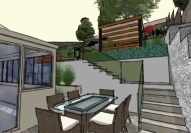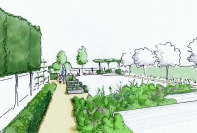Garden Design Projects in Hampshire and the Isle of Wight
We have compiled a selection of Rumbold–Ayers' most recent garden design projects in and around Hampshire and the Isle of Wight: click on the “read more” links below to see the full story:Suburban Garden, Surrey/Hampshire borders
 Summary: Garden design for a steeply sloping circa 11m x 11m back garden, associated with a house extension
Summary: Garden design for a steeply sloping circa 11m x 11m back garden, associated with a house extensionLocation: Surrey/Hampshire borders
Scope of work: Survey, Conceptual Plan and Visualisation, Detailed Design documentation
introduction
The house is a typical mid-late 20th Century semi-detached property, with brick and tile hung facing, situated within a suburban residential area. The back garden slopes upwards quite steeply, and is shaded by large trees on the neighbouring property. Plans include extending the house by adding a substantial orangery at the rear, and the creation of useable patio areas with a hot tub in the garden.
design solution
Steeply sloping sites, such as this, need to be terraced to create useable space. This typically involves the construction of retaining walls, in this case also to the sides bounding the neighbouring properties. The new orangery extension opens onto a secluded dining terrace, bounded by rendered retaining walls with trailing plants and steps with a glass balustrade leading to the middle level of the garden. The principal view from the long side of the orangery, towards a high masonry and stone-faced retaining wall, is enhanced with ornamental planting and an illuminated water-wall feature. The slate paving, white render and zinc galvanised planters combine to create a crisp, contemporary feel.

The middle level is the principal entertainment space. We designed a bespoke, contemporary style gazebo for the above-ground hot tub, with a small “bar” area to enable hot-tub users to socialise with other guests. The adjoining terrace area provides space for chairs or sun loungers. The hot-tub, terrace and planting are arranged to receive maximum sun, but still enjoy a sense of privacy despite the elevated position.
Steps lead up from the middle level to the top level, retained by a wall of stone-filled gabions. This area comprises planting and a gravel garden.
- planning permission granted Q4 2013
Semi-rural Garden, Isle of Wight
 Summary: Garden design for ⅓ acre maritime site, following house alterations and extension
Summary: Garden design for ⅓ acre maritime site, following house alterations and extensionLocation: Isle of Wight
Scope of work: Survey, Conceptual Plan and Visualisation

 introduction
introduction
This is a typical mid-late 20th Century “L”-shaped bungalow, constructed of reconstituted stone blocks, and with a characteristic long, narrow garden. Although in a rural setting, it stands cheek by jowl with similar bungalows on either side. As part of their plans to extend and improve the property, the new owners wanted to improve the privacy, aesthetics, and usability of the front and back gardens.
the brief
In addition to an extensive deck, the brief called for a separate evening terrace, kitchen garden and fruit trees. An strong “sense of arrival”, together with greater privacy, were the principal objectives in the front garden.
design solution
The approach, across a short, tar-sprayed gravel drive and turning area, leads unambiguously to the front door, with planting on both sides to provide a pleasant welcome. The front garden is bounded by a variety of garden trees to the south and east, and pleached lime trees to the west, providing an appropriate sense of privacy, and a place to sit in the sun looks across a semi-formal lawn area
The principal access to the rear garden is through the full width opening doors from the dining room, which open onto a substantial deck, bounded by generous ornamental planting and wide steps leading down to the cherry tree lined path. Further planting under the cherry trees provides interest as you walk to the evening terrace at the far end of the garden.
The evening terrace enjoys views across meadows beyond the north boundary, and roof-trained trees provide some shade and a sense of shelter while still keeping the natural feel of the setting - away from the house.
The curved margin of the lawn, bounded by uncut meadow grass with native trees and hedging, invites a different route back to the house.
The route back to the house takes you past the raised beds of the kitchen garden, integrated into ornamental planting. Pleached limes and espaliered apple trees provide effective visual screening.
Designing a Hampshire Garden
If you're looking for further garden design inspiration, there are some excellent gardens to visit in Hampshire, including:- Exbury Gardens near the New Forest – 200 acres of mainly woodland, including the Rothschild Collection of rhododendrons, azaleas, magnolias and camellias. Also great for autuman colour.
- Sir Harold Hillier Gardens, Romsey – one of the most important modern plant collections in the world. Arboretum, herbaceous borders, famous winter garden, etc..
- Mottisfont Abbey near Romsey – Lime Walk designed by Geoffrey Jellicoe in 1936 and Rose Garden planted by Graham Stuart Thomas with pre-1900 shrub roses.
The Isle of Wight is an intimate, small scale landscape, with geology that mirrors mainland Hampshire - two ranges of chalk downs with a tiny remnant of acid heathland between, and mainly clay farmland along the northern coast. Traditional building materials are local limestone and sandstone, and the gentle climate invites the use of more tender maritime planting characteristic of many Isle of Wight gardens. The undercliff and coastal chines are another distinctive aspect. Depending on location, Isle of Wight gardens range from traditional cottage gardens to contemporary waterside properties.
So, if you're wondering what to do next, why not call us for an informal chat on (01722) 714443.
Please read our Privacy Statement
